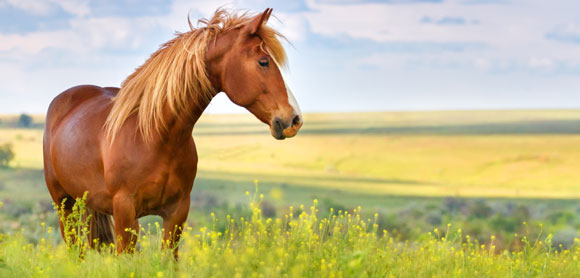
Keeping your horse safe from poisonous plants: How to spot them and what to do
What plants are poisonous to horses and what should you do if your horse eats something poisonous? Learn more about which plants to look out for and Petplan Equine veterinary expert Gil Riley shares his emergency equine poisoning protocol.
Weeds are great at outcompeting other plants. If there are more weeds than grass in your pasture, then your horse may start eating something they shouldn’t.
Unfortunately, horses aren’t always the best judges of which plants can do them harm. Keeping an eye on any poisonous weeds or hedgerow plants in your pasture means you can deal with them before they become a problem.
Which plants are poisonous to horses?
Some plants like blackberries and willow are great for your horse to forage. Others, like ragwort and mallow, are poisonous and should definitely be avoided. Our interactive guide can be used to find out more information about some common weeds and hedgerow plants.
Acorns - TOXIC
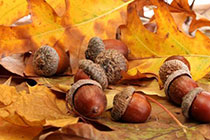 Over engorgement can lead to acute colic and kidney failure, can be fatal.
Over engorgement can lead to acute colic and kidney failure, can be fatal.
Blackberries – GOOD
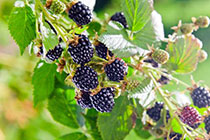 Rich in anti-oxidants and Vitamin C. If feeding blackberry try to avoid feeding the thorns, which could lodge in the lips or tongue and cause an infection.
Rich in anti-oxidants and Vitamin C. If feeding blackberry try to avoid feeding the thorns, which could lodge in the lips or tongue and cause an infection.
Blackthorn (aka Sloes) - Non-toxic
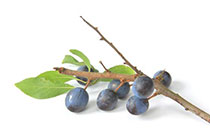 Blackthorn has a very high roughage content so could potentially cause an impaction if consumed in excess. An impaction is a common type of colic that can develop if a horse eats an excess amount of dry roughage.
Blackthorn has a very high roughage content so could potentially cause an impaction if consumed in excess. An impaction is a common type of colic that can develop if a horse eats an excess amount of dry roughage.
Brambles - Non-toxic
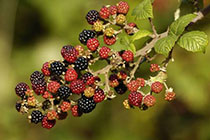 Non-toxic but the thorns can cause damage to the lips and tongue, possibly permitting an infection to become established.
Non-toxic but the thorns can cause damage to the lips and tongue, possibly permitting an infection to become established.
Chalk stream watercress - Good
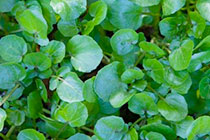 Horses love to graze on Watercress. This plant has been considered to be an antioxidant and a digestive aid.
Horses love to graze on Watercress. This plant has been considered to be an antioxidant and a digestive aid.
Cherry - TOXIC
 Harmful in large quantities. Seeds contain cyanide but fortunately at a very low concentration.
Harmful in large quantities. Seeds contain cyanide but fortunately at a very low concentration.
Clovers - Non-toxic (in moderate quantities)
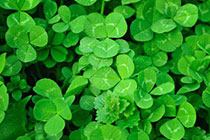 High quantities of White (Alsike) clover can lead to a painful skin condition that occurs on the white socks of horses- it bears a resemblance to mud fever. Clovers can also be colonized by various types of mould and one of these causes a black pigmentation of the tongue and the horse to salivate excessively.
High quantities of White (Alsike) clover can lead to a painful skin condition that occurs on the white socks of horses- it bears a resemblance to mud fever. Clovers can also be colonized by various types of mould and one of these causes a black pigmentation of the tongue and the horse to salivate excessively.
Coarse Grasses - Non-toxic
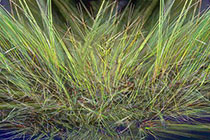 Coarse grass is non-toxic but often not palatable enough for horses to enjoy eating.
Coarse grass is non-toxic but often not palatable enough for horses to enjoy eating.
Cow parsley - GOOD
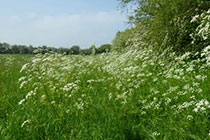 Horses can eat cow parsley because it is nutritious and assists in digestion. It is believed Cow parsley also aids the wound healing process and it has qualities similar to fennel. It is common at the base of hedges and around the edge of fields.
Horses can eat cow parsley because it is nutritious and assists in digestion. It is believed Cow parsley also aids the wound healing process and it has qualities similar to fennel. It is common at the base of hedges and around the edge of fields.
Dandelions - Non-Toxic
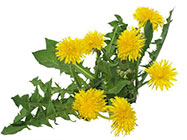 They do have a sour taste so horses will tend to avoid eating if possible.
They do have a sour taste so horses will tend to avoid eating if possible.
Field Horsetail - Moderate
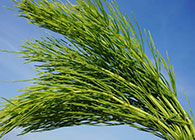 Tolerated in moderate quantities but there have been signs of TOXICITY displayed in horses eating hay containing more that 20% Horsetail. Signs include progressive symptoms of weakness, staggering, nervousness, poor vision, muscular weakness and constipation. Fatalities can occur, but the immediate removal of contaminated food brings about rapid recovery.
Tolerated in moderate quantities but there have been signs of TOXICITY displayed in horses eating hay containing more that 20% Horsetail. Signs include progressive symptoms of weakness, staggering, nervousness, poor vision, muscular weakness and constipation. Fatalities can occur, but the immediate removal of contaminated food brings about rapid recovery.
Goose grass (Cleavers) - Non-toxic
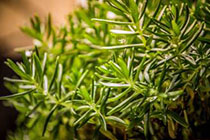 Most horses will tend to avoid eating Goose Grass if they can.
Most horses will tend to avoid eating Goose Grass if they can.
Gorse - Non-toxic
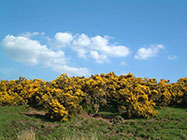 Typically avoided by horses. If any gorse is found in the fields your horse grazes, consider getting a goat as a pasture companion as they are excellent at clearing gorse.
Typically avoided by horses. If any gorse is found in the fields your horse grazes, consider getting a goat as a pasture companion as they are excellent at clearing gorse.
Hawthorn - GOOD
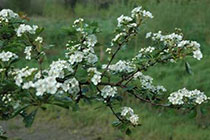 Flavonoids present in Hawthorn have shown to enhance the connective tissue structure of the endothelial lining of heart cavities and the blood and lymph vessels.
Flavonoids present in Hawthorn have shown to enhance the connective tissue structure of the endothelial lining of heart cavities and the blood and lymph vessels.
Mallow - TOXIC
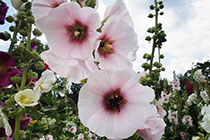 Toxic if eaten in large quantities, Mallow is a common weed in horse pastures. Signs of Mallow poisoning include profuse sweating, rapid breathing, incoordination (staggers) and muscle tremors.
Toxic if eaten in large quantities, Mallow is a common weed in horse pastures. Signs of Mallow poisoning include profuse sweating, rapid breathing, incoordination (staggers) and muscle tremors.
Nettles - Non-toxic
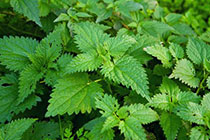 No deleterious effects. When nettles are young their sting is sharper but if they are cut and allowed to wilt, the sting goes out of them and the horses like to eat them. As nettles age they become drier, the sting weakens and horses will eat them from the stalk.
No deleterious effects. When nettles are young their sting is sharper but if they are cut and allowed to wilt, the sting goes out of them and the horses like to eat them. As nettles age they become drier, the sting weakens and horses will eat them from the stalk.
Plantains - Non-toxic
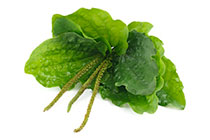 Palatable to horses and may be selectively grazed before grasses or legumes. A perennial ‘weed’, often found on roadsides and in ditches.
Palatable to horses and may be selectively grazed before grasses or legumes. A perennial ‘weed’, often found on roadsides and in ditches.
Ragwort - TOXIC
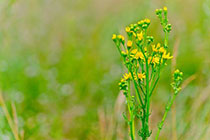 Each mouthful will irreparably kill some liver tissue. No amount is safe! It is widely accepted that the plant loses its unpleasant taste when it dies but even in this state it is still very dangerous. This means that ragwort found in hay or haylage, or leaves that have fallen off a plant in the field and died, can very easily be eaten unknowingly and will be just as harmful as a living plant.
Each mouthful will irreparably kill some liver tissue. No amount is safe! It is widely accepted that the plant loses its unpleasant taste when it dies but even in this state it is still very dangerous. This means that ragwort found in hay or haylage, or leaves that have fallen off a plant in the field and died, can very easily be eaten unknowingly and will be just as harmful as a living plant.
Rosehips - GOOD
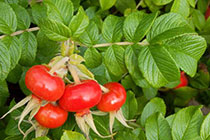 Rich in Vitamin C and contains potential anti-inflammatories. Several “natural” products are marketed purporting to have anti-inflammatory effects on the basis of their containing rosehip but evidence thus far is anecdotal.
Rich in Vitamin C and contains potential anti-inflammatories. Several “natural” products are marketed purporting to have anti-inflammatory effects on the basis of their containing rosehip but evidence thus far is anecdotal.
Thistles - Non-toxic
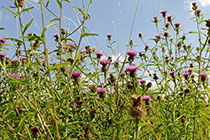 Some horses love to eat thistles, even favouring the spiky heads although for us it doesn’t look very comfortable watching them scoff it!
Some horses love to eat thistles, even favouring the spiky heads although for us it doesn’t look very comfortable watching them scoff it!
Wild camomile - Non-toxic
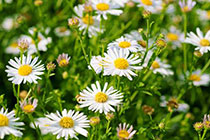 Aromatic and slightly bitter taste similar to apples, many horses love it!
Aromatic and slightly bitter taste similar to apples, many horses love it!
Wild celery - Non-toxic
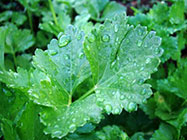 Wild celery is found mainly on boggy riversides and marshy ground, as it needs wet conditions to grow.
Wild celery is found mainly on boggy riversides and marshy ground, as it needs wet conditions to grow.
Wild garlic - Good
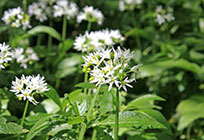 Wild garlic is considered to have fly repellent properties as horses apparently excrete the sulphur contained in the garlic through their skin. It has also been suggested consumption of garlic helps maintain the intestinal bacteria that play a very important role in the horses’ digestive processes.
Wild garlic is considered to have fly repellent properties as horses apparently excrete the sulphur contained in the garlic through their skin. It has also been suggested consumption of garlic helps maintain the intestinal bacteria that play a very important role in the horses’ digestive processes.
Willow - GOOD
 Contains Salicylic acid (we know as aspirin), a pain reliever and anti-inflammatory.
Contains Salicylic acid (we know as aspirin), a pain reliever and anti-inflammatory.
Yew trees (Taxus baccata). – TOXIC
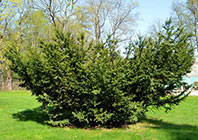 These are deadly poisonous to horses. They are so toxic that even chewing on a single branch can (and frequently does) cause INSTANT death. Fortunately Yew is very bitter tasting and most horses will not eat it – however in circumstances when forage is short they will sometimes chew Yew with fatal consequences. PLEASE be aware of this risk and warn other horse owners. For centuries Yew has been grown around church yards to ensure that livestock cannot gain access and some of the Yew trees in the UK are of tremendous age (one is known to be over 4,000 years old). Horse owners are not always aware of just how dangerous this plant is. Always ensure that Yew clippings are never put into the same field as horses that are grazing. Most parts of the tree are toxic, except the bright red aril surrounding the seed. The foliage remains toxic even when wilted. The major poison within the yew is the alkaloid taxine. It is a cardio-toxin and the effect it exerts on the heart causes fibrillation and acute cardiac arrest. There is no treatment and the death is acute, often with a single mouthful.
These are deadly poisonous to horses. They are so toxic that even chewing on a single branch can (and frequently does) cause INSTANT death. Fortunately Yew is very bitter tasting and most horses will not eat it – however in circumstances when forage is short they will sometimes chew Yew with fatal consequences. PLEASE be aware of this risk and warn other horse owners. For centuries Yew has been grown around church yards to ensure that livestock cannot gain access and some of the Yew trees in the UK are of tremendous age (one is known to be over 4,000 years old). Horse owners are not always aware of just how dangerous this plant is. Always ensure that Yew clippings are never put into the same field as horses that are grazing. Most parts of the tree are toxic, except the bright red aril surrounding the seed. The foliage remains toxic even when wilted. The major poison within the yew is the alkaloid taxine. It is a cardio-toxin and the effect it exerts on the heart causes fibrillation and acute cardiac arrest. There is no treatment and the death is acute, often with a single mouthful.
Sycamore Seeds - TOXIC
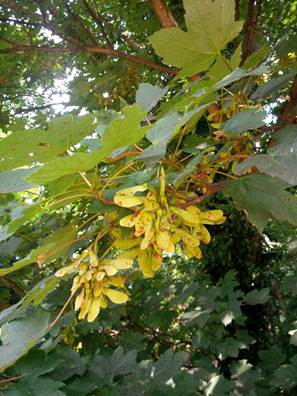 Sycamore seeds have been recently identified as the cause of Atypical Myopathy, a distressing disease of sudden onset in horses of all ages. The seeds contain a toxin (Hypoglycin A) which causes damage to cardiac, skeletal (postural) and respiratory muscles after ingestion by the horse. The condition is fatal in well over 50% cases. It is most common in the autumn when most of the seeds fall but can be seen all year round.
Sycamore seeds have been recently identified as the cause of Atypical Myopathy, a distressing disease of sudden onset in horses of all ages. The seeds contain a toxin (Hypoglycin A) which causes damage to cardiac, skeletal (postural) and respiratory muscles after ingestion by the horse. The condition is fatal in well over 50% cases. It is most common in the autumn when most of the seeds fall but can be seen all year round.
Fence off sycamore trees, sweep up the seeds (or use a Poo-hoover if you're lucky enough to have one) and remember that because of their shape the seeds can travel quite far. Providing good grazing or supplementary feed at pasture means horses are less likely to eat the seeds. A lower stocking density is associated with decreased risk as well as there is more grass to go round.
What to do if your horse eats something poisonous
- Call your vet.
- Remove your horse from the paddock if possible and put them in the stable while you wait for your vet to arrive. Treatment will depend on what your vet believes to be the poison at work.
- Check for symptoms and possible poisons. Your vet will want to know why you suspect your horse has eaten something poisonous. Being able to describe your horse’s presentation will be a big help to them.
- Is your horse behaving abnormally in the field?
- Is he staggering or uncoordinated?
- Is he showing symptoms of colic?
- Is he drooling excessively?
Is there anything in their field that could be poisonous? For example:
- Ragwort. Contains a toxin that causes profound liver damage.
- Buttercups. Contain a toxin that ‘burns’ the lips.
- Clover. A fungus can grow on clover that causes excess salivation.
- Oak trees. Acorns eaten in large quantities can cause intestinal upset (colic, diarrhoea) and even kidney failure.
- Sycamore seeds/saplings. Causes muscle weakness, lying down and, if untreated, death.
- Yew tree. Causes sudden (sometimes almost instantaneous) death.
The signs your horse presents and what plants are in their paddock will help your vet narrow down the possible cause.
Treatment and next steps
Treating the signs (e.g. pain relief for colic) will be the first step. Next, rehydration is often an important part of any care, either stomach tubing or intravenous administration of fluids and electrolyte to replace lost fluids, to ‘dilute’ the concentration of toxin ingested and to help encourage excretion of the toxin by flushing it out of your horse’s system.
Once the critical care is underway, your vet may need to perform some blood tests.
In cases of buttercup or clover poisoning, simply removing your horse from the plant is sufficient to start a resolution of the condition but in acorn poisoning, a blood test will give information on whether the kidneys are compromised.
If your vet suspects ragwort poisoning, then a blood test may reveal how damaged the liver may be. Sycamore poisoning is identified by profound muscle damage detected on the blood test.
The blood results will give an indication as to whether you have caught the illness in its early stages and thus have a reasonable chance of recovery, or whether any upturn resulting from the emergency medical treatment will unfortunately not be likely to stop deterioration.
How to stop poisonous plants from growing
Keeping your paddocks in good condition is the best way to maintain good-quality grazing and keep weeds at bay. Spring is the best time to start. Learn more in our guide to spring pasture management for horse owners.



